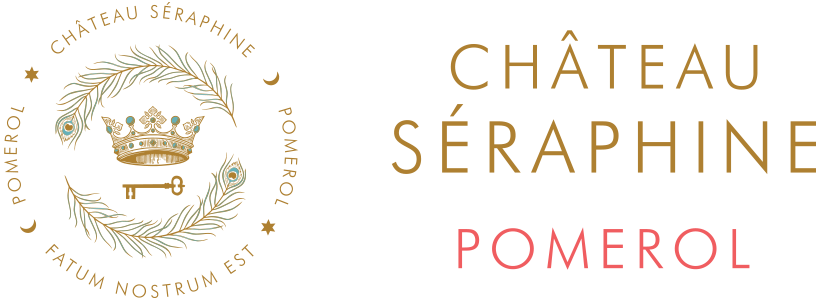Château Séraphine 2021
“Incredibly aromatic and floral on the nose and the palate. I love the texture - tannins are sleek, suave, intense and concentrated but so silky too. Finessed red and blue fruits - blueberries red cherries and plums - combine with more savoury elements of liquorice, cinnamon, dark chocolate, smoked earth and mint, but all quite crisp and precise. You can feel the pent-up energy right now - there's an underlying vibration to the fruit giving an overall sense of excitement. “
— Georgie Hindle, Decanter Magazine
Tasting Note
Deep and dense in colour this wine opens with soft elegant and enticing aromas of blackberry preserves, elderberries, cassis, violets, as well as Chinese five spice and cinnamon stick over a core of blueberry compote, black cherries, and rich Havana tobacco smoke.
On the palate the wine is generously opulent, packed with lingering spicy notes and freshly cracked white pepper followed by gentle hints of cacao, roasted coffee, and dense briary black fruit with a generous natural purity of expression and nothing exaggerated. Dense and savoury.
There is also great tension here too, which is nicely balanced by the beautiful freshness of the wine, good acidity and a lovely inky mid-palate buoyancy that leads to silky soft polished tannins and an exotic, velvety long finish.
Vineyard
Our vineyard has an overall surface of 2.2 hectares but is split into two parcels of vines. At Plince, we have 1 hectare of vines situated on a well-draining slope of sandy topsoil over clay and deep gravels and 0.4h of this plot was replanted with Cabernet Franc in April 2017 at 8000 vines per/h.
The second block at Mazeyres is 1.2h and is also laid out in two distinct sections. The first part consists of a raised deposit of deep gravels on 0.6h and is planted with old Merlot vines. The second part sits on a gently sloping 0.6h and is a patchwork of shallow sandy soils over gravels and blue clay (smectite) and was replanted with Merlot in April 2017 at 8,000 plants per/h.
We work exclusively by horse for all our soil works including under row ploughing and tilling and employ eco-friendly viticultural practices.
However, as the 2021 growing year progressed from March into April there was also a significant threat of severe frost damage and so we took defensive action by distributing candles into the most vulnerable parcels and lighting them on four early mornings. We also carefully monitored the changing weather pattern throughout the year and adjusted our work practices accordingly to protect our vines from disease and mildew. Later in the year, this also included ‘green harvesting’ on several occasions to adjust the crop size and to further take the pressure off the vines.
Vinification
One day of cold soak (10°C) followed by alcoholic fermentation (26-28°C) for 9-10 days with regular ‘remontage’ and a single ‘delastage’. Post fermentation extended maceration (28°C) for 3 weeks followed by malolactic fermentation in 300L new oak barrels.
After malolactic fermentation was complete, the wine was racked off its lees into barrel (40% new, 60% second/third fill) where it will now age for the next 12-14 months.
We also filled a 1000L Clay Amphora by gravity with Cabernet Franc from our five- year-old vines at Plince and directly from the sorting table using a small conveyor. Then following the completion of the fermentation, the wine was racked and returned to the Amphora for ageing for a further 12-14 months.
Grape Variety: 95% Merlot, 5% Cabernet Franc
Alcohol: 13.5% by volume
RS: Less than 2 g/l
Production: 3200 bottles
Harvest Notes 2021
After an uneventful start to the growing year but just as March slipped effortlessly into April, ‘mother nature’ played one her deadliest cards and as the night-time temperatures dropped sharply, we were faced with the significant threat of crippling frosts.
In response, we quickly deployed hundreds of frost candles to protect our most vulnerable vines and placed our team on standby, ready to light the candles if the mercury fell to critical levels. Then, as the temperatures subsequently dropped dangerously low on four nights, we lit the candles several hours before daybreak. However, by the end of month, we were relieved to see that the frosts had done little damage to our vines.
From mid-April onwards, conditions remained unsettled in May and on well into early June, although the flowering and fruit set in mid- June was quite successful. However, when yet more wet and humid weather arrived in late June, there was renewed pressure of disease and mildew which remained a constant threat during July and August.
As September progressed the weather further improved and with a welcomed window of opportunity, we finally commenced harvest under cool blue skies on Friday 24th September picking the young Merlot at Mazyres followed by the older Merlot at Plince on Monday 27th. We then continued with the older Merlot vines at Mazeyres on Tuesday 28th September, but then waited until Monday 4th October to pick the young Cabernet Franc at Plince... and harvest was over.
In the winery, the fruit was carefully loaded from small baskets onto a first-sorting table and then de-stemmed using our precision CUBE system followed by a berry hand-sorting table and a gentle crushing before arriving in the fermentation tanks by gravity.
The average yield was approximately 25hl/h for the older vines although not all the fruit will go into the Grand Vin and 35hl/h for the younger vines, most of which will only enter into the ‘second’ wine.



